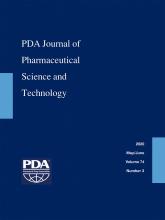Abstract
It is generally acknowledged that quantitation in extractables and leachables (E&L) can be variably reproducible and accurate, depending on the quantitation approach taken. This is especially true for “simple” quantitation, which is the practice of estimating an analyte's concentration based on its response relative to that of an internal standard that has been added to the sample in a known amount. Simple quantitation is prone to error and variation as it is based on the largely false premise that the response factors for all extractables, leachables, and internal standard candidates are the same. It has been proposed that this uncertainty (inaccuracy and variation) be accounted for by adjusting two key parameters in E&L assessment, the reported concentrations themselves and the analytical evaluation threshold (AET) via an uncertainty factor (UF). This paper examines quantitation variation and discusses the means of establishing and utilizing the UF to adjust the AET to lower values and to adjust reported concentrations to higher values, enabling an impact assessment performed with this data to be more protective of patient safety. Although adjustment of the AET lower with the UF is supported, flaws in the concept of using the UF to adjust reported concentrations upward are considered, and it is recommended that the UF not be used in this manner. Rather, E&L quantitation should be based on compound-specific relative response factors, collected and collated in an E&L database.
- Extractables
- Leachables
- Analytical evaluation threshold
- Quantitation
- Uncertainty factor
- Safety risk assessment
- © PDA, Inc. 2020
PDA members receive access to all articles published in the current year and previous volume year. Institutional subscribers received access to all content. Log in below to receive access to this article if you are either of these.
If you are neither or you are a PDA member trying to access an article outside of your membership license, then you must purchase access to this article (below). If you do not have a username or password for JPST, you will be required to create an account prior to purchasing.
Full issue PDFs are for PDA members only.
Note to pda.org users
The PDA and PDA bookstore websites (www.pda.org and www.pda.org/bookstore) are separate websites from the PDA JPST website. When you first join PDA, your initial UserID and Password are sent to HighWirePress to create your PDA JPST account. Subsequent UserrID and Password changes required at the PDA websites will not pass on to PDA JPST and vice versa. If you forget your PDA JPST UserID and/or Password, you can request help to retrieve UserID and reset Password below.






